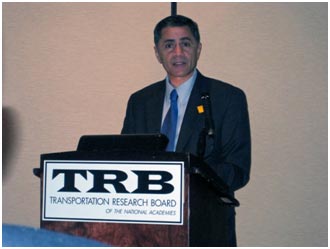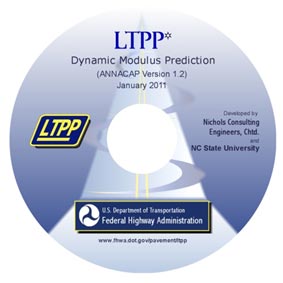U.S. Department of Transportation
Federal Highway Administration
1200 New Jersey Avenue, SE
Washington, DC 20590
202-366-4000
Federal Highway Administration Research and Technology
Coordinating, Developing, and Delivering Highway Transportation Innovations
|
LTPP News This newsletter is an archived publication and may contain dated technical, contact, and link information. |
|
| Publication Number: FHWA-HRT-11-066 Date: Summer 2011 |
Publication Number:
FHWA-HRT-11-066
Issue No: Vol. 7 No. 2 Date: Summer 2011 |
| Email Distribution List |
|
| Contact |
Customer Service
|

FHWA Administrator, Victor Mendez
The State Coordinators’ Meeting at the 2011 Transportation Research Board (TRB) Annual Meeting focused on using the Long-Term Pavement Performance (LTPP) program to provide benefit to State transportation departments. Federal Highway Administration (FHWA) and American Association of State Highway and Transportation Officials (AASHTO) leadership set the tone by expressing support for LTPP. Individual States provided practical examples of how LTPP can be used to produce cost savings in the field.
FHWA Administrator Victor Mendez offered opening remarks. As the former Chair of the TRB LTPP Committee, Administrator Mendez stated that he stays in touch with the program and tracks progress to make sure the program is strategically focused. It is his view we should not lose sight that States are using LTPP data to support their analyses, as evident by the number of papers presented at this year’s annual meeting that used LTPP data and products. Administrator Mendez’s top priority is innovation. Using the Every Day Counts initiative, he challenged the audience to apply the same thinking to LTPP—that is—bring the benefits of LTPP to the public sooner. The Administrator reminded the LTPP State Coordinators that LTPP is the States’ program and they should be using LTPP data and products for their benefit. He concluded his remarks by reinforcing that we should all be ambassadors not just for pavements, but for safety as well.
Dr. Anthony Kane, Director of Engineering and Technical Services for AASHTO, provided comments that reinforced Mr. Mendez’s points. Dr. Kane stated that AASHTO supports the program and that they recommended a funding level suitable to continue data collection, analysis, and product development activities under their authorization proposal for the next highway legislation.
Mr. Bill Temple, Chair of the TRB LTPP Committee (sponsor of the session), spoke briefly about the many changes that have taken place over the years since the beginning of the program. He issued a challenge to the audience for State transportation departments to become more involved with LTPP. He stated that it is important for them to share the products and benefits of LTPP. He noted that DataPave Online contributes significantly to this process and promoted its use.
In support of Mr. Temple’s comments, participants were provided with specific examples of how LTPP products and DataPave Online are being used across the country. There were four presentations made by current or former LTPP State Coordinators to showcase how LTPP has benefited their particular State.
Implementation of Proven LTPP Practices in Colorado
Mr. Ahmad Ardani, former LTPP State Coordinator for Colorado gave an engaging presentation on how LTPP was implemented in his State. He explained that the leaders in Colorado supported the program and wanted to put the information to use, not sit latent on the shelf.
Mr. Ardani’s presentation discussed how Colorado implemented several LTPP products, some of which will be mentioned here. The first major impact LTPP had on the way Colorado does its work was in the area of slab widening for Portland cement concrete (PCC) pavements. The Specific Pavement Study (SPS) -2 Experiment: Strategic Study of Structural Factors for Rigid Pavements was the source Colorado used to evaluate if widening the slabs would improve performance of PCC pavements. They found that widening the slabs by 2 feet improved performance.
So, in 1998 Colorado implemented wider slab design across the State and is still using this practice today.
Colorado also examined the SPS-4 Experiment: Preventive Maintenance for Rigid Pavements and found that 1/8” single-cut joints were effective and required less sealant and labor. They were also quieter and saved Colorado $0.57 per linear foot. The State implemented this practice in 1997 and Mr. Ardani mentioned that this practice was also implemented in Louisiana.
LTPP in Mississippi
Mr. James Watkins, newly appointed LTPP State Coordinator for Mississippi, who has been involved with the program throughout the years, noted that his State was the first one to implement a SPS site. Some of the key products they have implemented include using the Falling Weight Deflectometer (FWD) Calibration Center regularly to calibrate their FWDs and the Distress Identification Manual for their State warranty and pavement management programs. They plan to start implementing the latest version of the Profile Viewer and Analyzer (ProVAL) software (developed originally from the LTPP profile quality control software ProQual).
Use of DataPave Online to Develop IRI Models for New Jersey’s Pavement Management System
New Jersey’s former LTPP State Coordinator, Dr. Nick Vitillo reported on results they found in using DataPave Online to verify and refine International Roughness Index (IRI) models for their Pavement Management System to trigger when a pavement is in need of repair.
According to Dr. Vitillo, pavements require rehabilitation because of distress not IRI; at least that is what they found to be true in New Jersey. If a pavement is built smooth, it stays smooth longer. The State’s default IRI performance models triggered rehabilitation at 170 inch/mile or 9 years. To validate this, New Jersey used the data from their State’s SPS-5 (Rehabilitation of Asphalt Concrete Pavements) and SPS-9A (SuperPave Asphalt Binder Study) test sites from DataPave Online and the results predicted a much greater life than 9 years. In fact, it would take more than 20 years for a pavement to reach an IRI of 170 inch/mile before any type of treatment would be required. Neither New Jersey’s dataset (using some of the State’s 1999 construction projects) nor data from DataPave Online (using LTPP SPS test sites) ever reached the trigger IRI value of 170 inch/mile.
Dr. Vitillo made it clear that without access to DataPave Online, New Jersey would not have been able to develop realistic enhanced IRI prediction models.
Indiana’s Use of LTPP Data for MEPDG Implementation
The final presentation on State use of LTPP data and its products was given by Mr. Tommy Nantung, who serves as Indiana’s LTPP State Coordinator. Mr. Nantung discussed a topic that has been the focus of pavement engineers and researchers for the past several years—implementation of the Mechanistic-Empirical Pavement Design Guide (MEPDG).
Traffic data is probably the most important input parameter for the MEPDG. According to Mr. Nantung, LTPP traffic (and soils) data is the most reliable data to use because of the quality control measures performed on this data. Indiana has 21 weigh-in-motion (WIM) sites in their State and they now wish they had more for implementing the MEPDG. They implemented the MEPDG in January 2009 and in just 1 year Indiana estimates savings of more than $10M from use of the MEPDG on new pavement designs alone. Mr. Nantung stated that Indiana uses LTPP data for verification because it is of high quality and he encouraged the audience to do the same.
To summarize the State Coordinators’ Meeting, Mr. Aramis López, LTPP Team Leader, challenged the audience to give LTPP products a try in their State. The coordinators were urged to use LTPP data and products and to modify them as necessary to fit the particular State’s needs. As you have read, these four States have done just that with impressive results.
Leveraging the LTPP Experience for Collecting Quality WIM Data
In addition to the LTPP State Coordinators’ meeting, LTPP also held a technical session on how traffic data collection has been conducted as part of the LTPP SPS Traffic Data Collection Pooled-Fund Study. As described at the meeting, collecting quality WIM data requires a good procurement process; regular calibration and validation of WIM equipment; regular maintenance of WIM equipment and daily checks of the data; regular processing and quality control of the data; and well-documented procedures.
The LTPP program office would like to thank the LTPP Committee for their leadership and continued support of these sessions. As we make plans for next year’s meetings, we welcome any State who would like to make a presentation on how they have used, are using, or plan to use the data or products from LTPP. If you would like to be considered to speak, please contact Deborah Walker at deborah.walker@dot.gov or (202) 493-3068. For more information about the LTPP program or to get a copy of the State or traffic data collection presentations, contact the LTPP Customer Support Service Center at ltppinfo@dot.gov or (202) 493-3035.
New! LTPP Webinars
LTPP plans to begin holding Webinars to discuss the status of the program, showcase products, and present case studies resulting from the research. LTPP is planning to have its first nationwide Webinar in September to provide an overview of the program and to share the schedule for future Webinars. Stay tuned!
New Publications
LTPP Program Highlights: Accomplishments and Benefits 1989-2009
The LTPP program has generated a wide range of benefits across the pavement engineering and management spectrum. Hundreds of applications have been identified that make use of LTPP data, and the utility of LTPP data is increasing. The benefits and accomplishments of LTPP to date, as discussed in these documents, have already provided a significant return on investment to the Nation. In the future, the LTPP program will yield additional information of tremendous value to pavement engineers and managers, who will translate this information into strategies and procedures for building better, safer, and more cost-efficient roads for the Nation.
Full Report (FHWA-HRT-10-071 2010) [PDF]
https://www.fhwa.dot.gov/publications/research/infrastructure/pavements/ltpp/10071/10071.pdf
Summary Report (FHWA-HRT-10-072 2010) [PDF]
https://www.fhwa.dot.gov/publications/research/infrastructure/pavements/ltpp/10072/10072.pdf
E* Computation of LTPP Sites
Dynamic modulus, |E*|, is a fundamental property of asphalt concrete mixtures. This property characterizes strain response as a function of loading rate and temperature. The significance of this material property is threefold. First, it is one of the primary material property inputs in DARWin-ME™, an AASHTOWare® pavement design software, which builds upon the National Cooperative Highway Research Program Project 1-37A MEPDG. Second, |E*| is one of the primary properties measured in the Asphalt Mixture Performance Test protocol that complements volumetric mix design with mechanical properties. Third, |E*| is one of the fundamental linear viscoelastic material properties that can be used in advanced pavement response models based on viscoelasticity.
A project was undertaken using the LTPP database to compute estimates of the dynamic modulus of hot-mix asphalt layers on LTPP test sections.

In addition to populating LTPP with |E*| data, a user-friendly software, LTPP* (known as LTPP Star), was developed to facilitate dynamic modulus computations. The executable software can batch process data from a file to compute large quantities of dynamic modulus estimates in accordance with the model hierarchy. The program has a feature that allows the user to manually input known parameters (such as hot-mix asphalt volumetrics or resilient modulus) and select a model to use in computing dynamic modulus. This software can be very useful for agencies that would like to estimate |E*| using legacy datasets or those limited to older test procedures.
This valuable software can be obtained at no cost from the LTPP Customer Support Service Center at ltppinfo@dot.gov or at (202) 493-3035.
Read more about this project in the TechBrief, LTPP Computed Parameter: Dynamic Modulus (FHWA-HRT-11-018) https://www.fhwa.dot.gov/publications/research/infrastructure/pavements/ltpp/11018/11018.pdf.
For more information, contact Larry Wiser at larry.wiser@dot.gov or (202) 493-3079.Join us on Facebook and YouTube to find FHWA’s latest news, information, and resources.